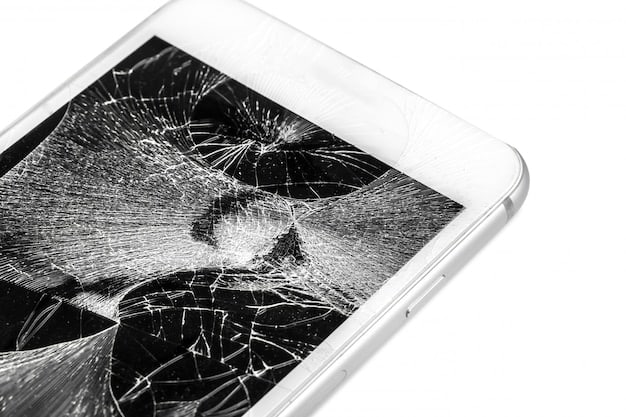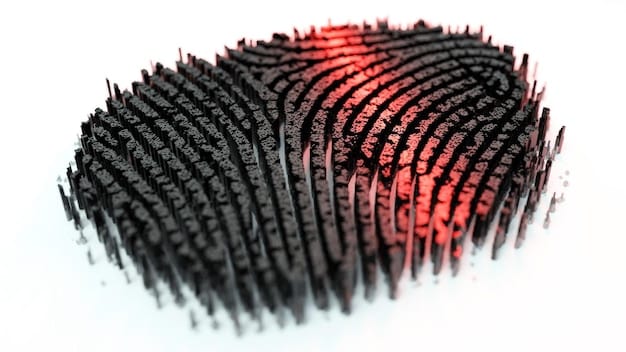Biometric Authentication Flaws: Risks & Multi-Factor Security

Biometric authentication flaws expose vulnerabilities to spoofing and breaches, necessitating the implementation of multi-factor authentication (MFA) to enhance security measures and safeguard sensitive data against evolving cyber threats.
The convenience of biometric authentication, such as fingerprint scanning or facial recognition, has become increasingly prevalent in modern security systems. However, beneath the surface of this user-friendly technology lie significant biometric authentication flaws that can compromise the security it intends to provide.
Understanding Biometric Authentication
Biometric authentication involves using unique biological traits to verify a person’s identity. These traits are difficult to forge and provide a convenient alternative to traditional passwords. However, understanding how these systems work is crucial to recognizing their potential vulnerabilities.
Types of Biometric Authentication
There are different biometric methods, each with its own set of strengths and weaknesses.
- Fingerprint Scanning: Uses unique patterns on a person’s fingertip for identification.
- Facial Recognition: Analyzes distinct facial features to verify identity.
- Iris Scanning: Scans the unique patterns in the iris of the eye for authentication.
- Voice Recognition: Identifies a person based on their unique voice characteristics.
Each of these methods works by capturing the biometric data, converting it into a digital template, and comparing it against stored templates in a database. A match confirms the user’s identity, granting access.
While each method offers a unique approach to verifying identity, they all share a common vulnerability: the potential for circumvention.
Common Biometric Authentication Flaws
Despite its advancements, biometric authentication is not foolproof. Several flaws can be exploited by malicious actors. Understanding these vulnerabilities is essential to mitigate risks and enhance security measures.

Spoofing Attacks
Spoofing involves creating fake biometric data to deceive the authentication system. For example:
- Fake Fingerprints: Using molds or high-resolution images to replicate fingerprints.
- Facial Spoofs: Presenting photographs, videos, or 3D masks to mimic a person’s face.
- Voice Mimicry: Employing sophisticated software to imitate a person’s voice.
These attacks exploit the system’s reliance on easily replicable biometric traits. The success of spoofing attacks highlights the need for liveness detection methods to ensure that the biometric data is captured from a real, live person and is not a fake representation.
These methods can involve analyzing subtle signs of life, such as blinking or micro-movements, to prevent spoofing attempts.
The Real Risks of Biometric Data Breaches
When biometric data is compromised, the risks are significant and long-lasting. Unlike passwords, which can be changed, biometric traits are permanent and immutable. This makes biometric data breaches particularly damaging.
Identity Theft and Fraud
Compromised biometric data can lead to severe consequences for individuals and organizations.
- Account Takeovers: Hackers gain access to sensitive accounts.
- Financial Fraud: Unauthorized transactions and theft.
- Reputational Damage: Loss of trust and credibility for organizations.
The potential for identity theft and fraud is significant when biometric data falls into the wrong hands. This makes protecting biometric data a critical concern for cybersecurity efforts.
The permanent nature of biometric traits means that once compromised, the damage is irreversible.

Implementing Multi-Factor Authentication (MFA)
To enhance security and mitigate the risks associated with biometric authentication flaws, implementing multi-factor authentication (MFA) is essential. MFA adds layers of security by requiring users to provide multiple forms of identification.
Combining Biometrics with Other Factors
MFA involves combining biometric authentication with other verification methods. For example:
- Knowledge Factors: Something the user knows, like a password or PIN.
- Possession Factors: Something the user has, like a smartphone or security token.
- Inherence Factors: Something the user is, like a fingerprint or facial features.
By requiring multiple factors, MFA makes it significantly more difficult for attackers to gain unauthorized access.
Even if one factor is compromised, the other factors provide additional barriers to entry.
Best Practices for Enhancing Biometric Security
Beyond implementing MFA, various best practices can further enhance the security of biometric systems.
Regular Security Audits
Conducting regular security audits is crucial for identifying vulnerabilities and ensuring that security measures are up to date. These audits should include:
- Penetration Testing: Simulating attacks to identify weaknesses in the system.
- Vulnerability Assessments: Scanning for known vulnerabilities and misconfigurations.
- Compliance Checks: Ensuring adherence to relevant security standards and regulations.
These audits help organizations stay ahead of emerging threats and maintain a strong security posture.
By regularly assessing and addressing vulnerabilities, organizations can minimize the risk of successful attacks.
The Future of Biometric Authentication
As technology evolves, so too will biometric authentication. Innovations are constantly being developed to address current flaws and enhance security.
Emerging Technologies and Trends
Several emerging technologies and trends are shaping the future of biometric authentication.
- Behavioral Biometrics: Analyzing unique behavioral patterns like typing speed or gait.
- Continuous Authentication: Verifying identity continuously throughout a session.
- AI-Powered Security: Using artificial intelligence to detect and prevent spoofing attacks.
These advancements promise to make biometric authentication more secure and reliable.
By leveraging these technologies, biometric authentication can adapt to evolving threats and maintain its effectiveness as a security measure.
| Key Point | Brief Description |
|---|---|
| 🔑 Biometric Flaws | Vulnerabilities can be exploited via spoofing and data breaches. |
| 🛡️ Multi-Factor Authentication | Adds layers of security by requiring multiple verification factors. |
| 🚨 Data Breach Risks | Compromised biometric data can lead to identity theft and fraud. |
| 🤖 Future Trends | Emerging technologies like AI and behavioral biometrics enhance security. |
FAQ
▼
The primary flaws include spoofing, where fake biometric data is used, and data breaches, where biometric information is stolen, compromising security.
▼
MFA adds extra layers by requiring users to provide more than one verification method, reducing the risk of unauthorized access if one factor is compromised.
▼
Such breaches can lead to identity theft, unauthorized financial transactions, and significant reputational damage for affected organizations and individuals.
▼
Regular security audits, penetration testing, and adherence to security standards are crucial for identifying and mitigating vulnerabilities effectively.
▼
Future trends include behavioral biometrics, continuous authentication, and the use of AI to improve the accuracy and reduce vulnerabilities within biometric systems.
Conclusion
As biometric authentication continues to evolve, understanding its flaws and implementing robust security measures like MFA are crucial. By staying informed and proactive, organizations and individuals can leverage biometric technology safely and effectively, minimizing risks and enhancing overall security.





